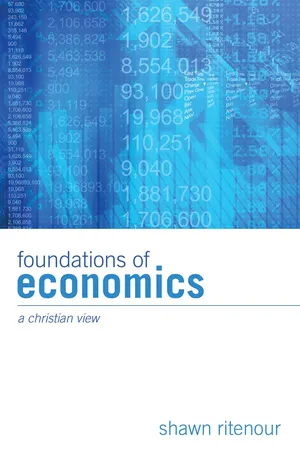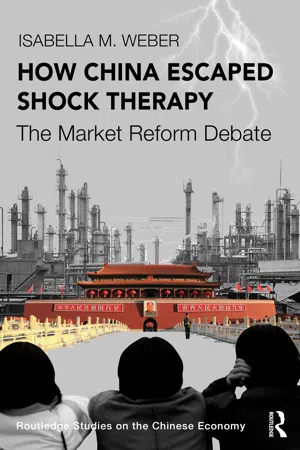Economics
Price Control
Price control refers to government regulations or policies that are implemented to influence the prices of goods and services in the market. It can take the form of price ceilings, which set a maximum price, or price floors, which set a minimum price. The aim of price control is to ensure affordability for consumers or to protect the interests of producers.
Written by Perlego with AI-assistance
Related key terms
1 of 5
7 Key excerpts on "Price Control"
- eBook - ePub
Foundations of Economics
A Christian View
- Ritenour(Author)
- 2010(Publication Date)
- Wipf and Stock(Publisher)
15 Price Controls I n the previous two chapters we introduced detailed analysis of one facet of government intervention in the economy. We analyzed the nature and consequences of interventionist macroeconomic policy and discovered that neither monetary inflation nor government spending are efficient ways to expand an economy. Macroeconomic policy, however, is only one category of state intervention in the economy. Another common form of intervention is Price Controls. Price Controls are the result of laws regulating prices at which people can legally buy and sell. Rarely do governments force buyers and sellers to accept a single price to make an exchange. Instead governments prefer to set maximum and minimum prices. Price Ceilings The form of Price Control governments often use in an attempt to thwart the negative consequences of monetary inflation is the price ceiling. As the name implies, a price ceiling is a maximum legal price. If you attempt to throw this textbook up into the air as far as it will go, what will stop it? What is the barrier above which it cannot fly? The ceiling. Just as the ceiling in an indoor room is the highest a thrown object can travel, a price ceiling is the highest price that buyers can legally pay and that sellers can legally accept. There are two types of price ceilings: effective and ineffective. We will initially investigate the consequences of an effective price ceiling, but first need to understand what we mean by the words effective and ineffective. Typically, those words are taken to mean that something either works well or does not. In our case, however, the terms refer to whether the price ceiling has an effect on the actual price that buyers pay and sellers receive in an exchange. An effective price ceiling hampers voluntary exchange from negotiating a market price - eBook - ePub
Power, Property Rights, and Economic Development
The Case of Bangladesh
- Mohammad Dulal Miah, Yasushi Suzuki(Authors)
- 2018(Publication Date)
- Palgrave Macmillan(Publisher)
uncertainty about the price level, or redistribution of wealth from the rich to the poor.Historical analysis shows that the Price Control was effected particularly during the period of economic instability when developing a competitive market price was uncertain (Chen 1999 ). For instance, during World War II, general Price Controls worked well in the USA. General price level and the rate of inflation were substantially lower than they would have been in the absence of price controls (Evans 1982 ; Mills and Rockoff 1987 ). It is difficult during the war to predict the price movement of a particular commodity and other factors that affect prices.However, evidences are aplenty in the literature showing that peacetime Price Control was also common in many economies (Cheung 1996 ; Rockoff 2004 ). Rent control for apartment is one of the frequently cited examples of Price Control (Arnott 1995 ; Autor et al. 2014 ; Cheung 1979 ; Olsen 1972 ). Besides rent control, other economic activities have gone through some phases of Price Control. For instance , Barzel (1997 ) reports that the US government initiated a price cap on gasoline during 1971–1974. Nillesen and Pollitt (2007 ) report that the Netherlands adopted several phases of Price Control for electricity distribution and transmission . Navissi et al. (1999 ) bring evidence of Price Control on equity markets in New Zealand listed public companies.Price Control can also be related to fixing the floor price for certain goods or services. Minimum wage rate is one prominent example of fixing the floor price (Lemos 2009 ). Although the rationale of minimum wage can be derived from Marxian egalitarian view of wealth distribution (see Elster 1986 ; Suzuki and Miah 2017 ), Adam Smith was also vocal in favor of minimum wage (Kaufman 2016 ). The basic argument in favor of minimum wage is that it attracts a greater number of workforce, which will reduce unemployment and increase the overall production (Giuliano 2013 - eBook - PDF
- Irvin B. Tucker, Irvin Tucker(Authors)
- 2016(Publication Date)
- Cengage Learning EMEA(Publisher)
In other markets, the government ’ s goal is to intervene and maintain a price higher than the equilibrium price. Market supply and demand anal-ysis is a valuable tool for understanding what happens when the government fixes prices. There are two types of Price Controls: price ceilings and price floors . EXHIBIT 3 Effect of Shifts in Demand or Supply on Market Equilibrium Change Effect on equilibrium price Effect on equilibrium quantity Demand increases Increases Increases Demand decreases Decreases Decreases Supply increases Decreases Increases Supply decreases Increases Decreases CHAPTER 4 | Markets in Action 103 Copyright 2017 Cengage Learning. All Rights Reserved. May not be copied, scanned, or duplicated, in whole or in part. Due to electronic rights, some third party content may be suppressed from the eBook and/or eChapter(s). Editorial review has deemed that any suppressed content does not materially affect the overall learning experience. Cengage Learning reserves the right to remove additional content at any time if subsequent rights restrictions require it. 4-2a PRICE CEILINGS Case 1: Rent Controls What happens if the government prevents the price system from setting a market price “ too high ” by mandating a price ceiling ? A price ceiling is a legally established maximum price a seller can charge. Rent controls are an example of the imposition of a price ceiling in the market for rental units. New York City, Washington, D.C., Los Angeles, San Francisco, and other communities in the United States have some form of rent control. Since World War I, rent controls have been widely used in Europe. The rationale for rent controls is to provide an “ essential service ” that would otherwise be unaffordable by many people at the equilibrium rental price. Let ’ s see why most economists believe that rent controls are counterproductive. Exhibit 5 is a supply and demand diagram for the quantity of rental units demanded and supplied per month in a hypothetical city. - eBook - ePub
- STEVEN PRESSMAN(Author)
- 2013(Publication Date)
- Taylor & Francis(Publisher)
maxima for a number of particular prices … helps a government to hold back the ultimate threat of galloping inflation. … Government restriction of particular prices is not then a policy either foredoomed to failure or necessarily futile’ (Pigou, 1941, p. 118).1.2. What is meant by Price Controls‘Price Controls’ does not necessarily mean government imposition of some precise price at which given commodities must be bought and sold. This is just one option among many. By ‘Price Controls’, authors like John Kenneth Galbraith meant a wide variety of policies by which market prices that are causing problems can be modified or influenced. Price Controls are thus a palette of measures among which the policy maker can choose according to the particular problem he wishes to solve or alleviate. In some cases it will be a legal maximum on a given price (as proposed by Smith for the rate of interest), in others a legal minimum (as the minimum wage), sometimes a minimum price at which the government promises to buy and a maximum at which it promises to sell (as for certain agricultural commodities), sometimes a temporary price freeze, and sometimes a maximum or minimum for price changes. This is probably why the plural word ‘controls’ is often used.The fundamental idea behind Price Controls is that if the free movement of certain prices produces very bad consequences (as during a mobilization for war), or if it makes it impossible, or very difficult, to attain some important national goal (like full employment without inflation or access to food for everyone), it is legitimate to keep an eye on these prices and eventually do something that makes the situation better. Most economists agree on this point, but then many go on to exclude Price Controls from the policy options that are on the table. Not Galbraith (1951, p. 15), who believed that ‘we cannot exclude from use any weapon that is necessary … it would be reckless to decide in advance that Price Controls should not be used’. - eBook - ePub
- Neva Goodwin, Jonathan M. Harris, Julie A. Nelson, Pratistha Joshi Rajkarnikar, Brian Roach, Mariano Torras(Authors)
- 2022(Publication Date)
- Routledge(Publisher)
But in other cases, especially where the elasticity of supply is high, Price Controls can be disastrous. One example is in Zimbabwe, where extensive Price Controls were imposed in 2007 with the goal of keeping prices for food and other essential goods low. As our example leads us to expect, the result of enforced low prices was to destroy the incentive for farmers and other suppliers to produce, leading to severe shortages. So, the poor people whom the policy was supposed to help were instead hurt by the unavailability of food and other basic goods. Meanwhile, farmers and other merchants were forced into bankruptcy. The Price Controls had to be abandoned after they forced the economy into virtual collapse.4.3 Price Floors
Governments also sometimes intervene in markets with the opposite goal—to keep prices from falling to the market equilibrium. A price set above the market price is called a price floor or “price support” (because it establishes a minimum allowable price).price floor: a regulation that specifies a minimum price for a particular productWhy would governments want to keep prices at higher levels? The obvious reason is to aid producers. Governments commonly specify minimum prices for agricultural products such as grain or milk. The goal is to help farmers, who often have considerable political influence. Of course, this also pushes up prices to consumers.The economic effect is the opposite of a price ceiling. Rather than creating a shortage, price floors tend to create a surplus, as producers increase their output to take advantage of profitable higher prices. But these higher prices cause consumers to cut back their purchases. In some cases, the government will buy up the surplus created by the price floor. From an economic point of view, this is clearly inefficient, because it encourages excess production and involves both higher prices to consumers and large government expenditures. Generally, economists would recommend a more efficient approach of giving direct aid to farmers, if this were considered necessary, but leaving market prices alone.Another classic example of a price floor is the minimum wage. Most governments have minimum wage laws specifying that hourly wages must be at least a given level. The United States has a federal minimum wage of $7.25 per hour (as of 2022), although about 30 states have set higher minimum wage rates. Most other developed countries have higher minimum wage rates. For example, the minimum wage is equivalent to about $10 per hour in Canada, about $11 per hour in France, and $15 per hour in Australia.6 - eBook - PDF
- David Besanko, Ronald Braeutigam(Authors)
- 2020(Publication Date)
- Wiley(Publisher)
9 We do not consider consumers to the right of point X on the demand curve because they would not be willing to rent housing at $1,000 even if they could find it. 435 10.2 PRICE CEILINGS AND FLOORS price ceiling with a graph like the one in Case 1 of Figure 10.7, assuming that the good ends up in the hands of consumers with the highest willingness to pay. This assump- tion is reasonable when consumers can easily resell the good to other consumers with a higher willingness to pay, but as Application 10.2 suggests, it may not hold in practice, even though they might not be able to obtain the good when it is initially sold. Before leaving rent controls, we note that government attempts to regulate the price of a commodity rarely work in a straightforward fashion. For example, when a shortage develops in the rental market for housing, some landlords may demand key money, or a fee—an extra payment from a prospective renter—before agreeing to lease an apartment. Although such payments are illegal, they are difficult to moni- tor, and renters who are willing to pay more than the rent-controlled price may will- ingly (though not happily) pay the key money. Landlords may also recognize that with excess demand, they will be able to find renters even if they allow the quality of the apartments to deteriorate. Rent control laws often attempt to specify that the quality should be maintained, but it is quite difficult to write the laws to enforce this intent effectively. Further, landlords may recognize that they would be better off in the long run if they can convert apartments under rent control to other uses not subject to price imposed. Consumers have had difficulty finding foods at regulated prices and have often had to wait in long lines to purchase those foods that were available. In a 2012 survey, powdered milk could not be found in 42 percent of grocery establishments. - eBook - ePub
How China Escaped Shock Therapy
The Market Reform Debate
- Isabella M. Weber(Author)
- 2021(Publication Date)
- Routledge(Publisher)
The supply of those factors of production whose prices have been limited shrinks. Then again the government must expand the sphere of its price ceilings. It must fix the prices of the secondary factors of production required for the production of those primary factors. Thus the government must go farther and farther. It must fix the prices of all consumers’ goods and of all factors of production, both material factors and labor.(ibid.)Hence, for von Mises (1974b [1950], 22–24), just as for Hayek, a “middle-of-the-road policy leads to socialism” and government control of, for example, the milk price appears to be enough to initiate a slip into central planning and destroy free competition.Despite such full-fledged theoretical attacks, Price Controls, whether effective or not, were a repeatedly used policy in the United States in the decades to come. Price Controls were reintroduced during the Korean War and in the years 1971–1973 by Nixon in the context of the Vietnam War. The prices of some commodities—including milk—still remain under government control (Mihm, 2017; Mills, 1975; Rockoff, 1984). The persistence of Price Controls encouraged Milton Friedman’s numerous attacks in a multitude of publications (e.g., Friedman, 1952, 1977; Friedman and Friedman, 1980; Friedman and Schwartz, 1963).Hayek submitted to the need of controls for the special case of wartime. In contrast, Friedman argues that the result of direct Price Control from ancient times onward “has always been the same: complete failure” (ibid., 17–18). For Friedman, “[i]nflation is always and everywhere a monetary phenomenon, resulting from and accompanied by a rise in the quantity of money relative to output” (ibid., 18). Hence, the only way to stop inflation is to stop the quantity of money from increasing. Friedman believes that “people are so stubborn about the amount they hold in the form of money” (ibid., 29) that whenever the overall quantity of money increases, they simply spend this additional amount rather than increasing their money holdings. Prices will rise and inflation will occur. Under such conditions of excess money, if the government controls the price of one commodity—for example, steel—all that will happen, in Friedman’s view, is that the pressure of money demand will be exerted on other commodities. The supply of steel would fall since, with the artificially low price, the producer cannot afford to produce more. Those who cannot satisfy their demand for steel, in Friedman’s logic, will turn to other materials as substitutes (ibid., 20).
Index pages curate the most relevant extracts from our library of academic textbooks. They’ve been created using an in-house natural language model (NLM), each adding context and meaning to key research topics.






